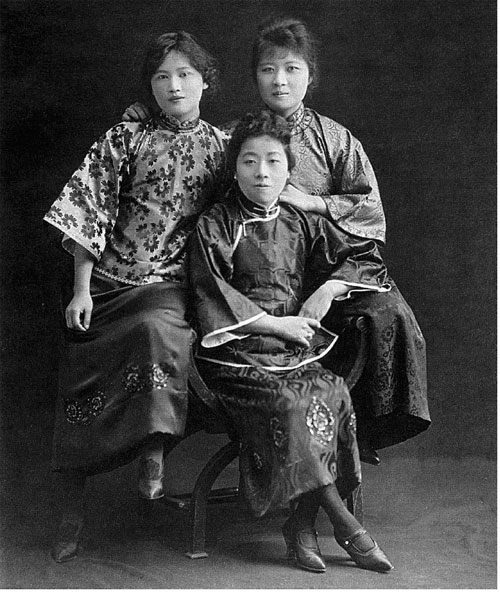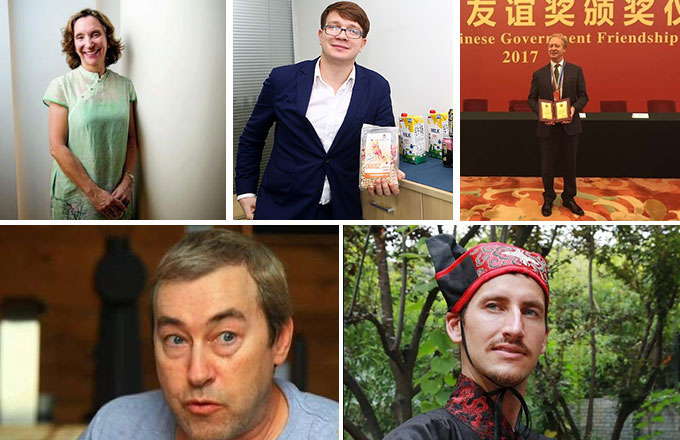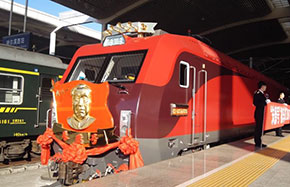Reunited at long last
|
The exhibition at Duoyunxuan Art Center showcases rare photographs like this one, in addition to artifacts including the clothes and daily utensils used by the sisters. |
A one of a kind exhibition about the Soong sisters
There has never been a trio of sisters more famous in China than the Soongs, and their contributions to the country and the war-time efforts have now been immortalized in a unique exhibition named "The Soong Sisters: Special Memories".
The exhibition, which occupies 2,500 square meters at the Duoyunxuan Art Center, debuted on April 28 and will run till July 31. It is jointly presented by Xinmin Evening News and the municipal management council for the cultural relics of Sun Yat-sen and Soong Ching-ling.
The 300 exhibits on show, which comprises original documents, photographs, video recordings, clothing, daily utensils and artworks, were collected from both sides of the Taiwan Straits.
The three women - Ai-ling (1888-1973), Ching-ling (1893-1981) and Mei-ling (1898-2003) - are well-known for their key roles in China's political scene throughout the 20th century. Two of them were once the first ladies of China - Ching-ling married Sun Yat-sen (1866-1925), also known as the "Father of Modern China" while Mei-ling wedded Chiang Kai-shek (1887-1975), the former leader of the Kuomintang government and president of the Republic of China. The eldest sibling, Ai-ling, was married to Kung Hsiang-hsi (1881-1967), the richest man in China in the early 1900s.
While Mei-ling and Ai-ling were ardent supporters of the Kuomintang (KMT), Ching-ling was steadfast in her Communism beliefs. Despite their differences in ideology, the three sisters nonetheless joined hands to lend vital support to war relief efforts in the fight against the Japanese invaders.
In 1940, when the Japanese occupied the capital city of Nanjing, the three reunited in Chongqing and established the Chinese Industrial Cooperatives. The three sisters had provided aid to numerous schools, hospitals, air raid shelters and war-torn communities.
Following the fall of the Kuomintang in 1948, Mei-ling and Ai-ling moved to Taiwan with their family, while Ching-ling stayed in the Chinese mainland. The three sisters never again met in person. Ai-ling and Mei-ling later moved to New York where they spent their last days while Ching-ling died in Beijing.
"The Soong sisters were born and raised in Shanghai. This is the first time the three of them are reunited since 1949 when they went their separate ways," says Chen Qiwei, chief editor of Xinmin Evening News.
"They were the elites of their time and role models for women in China. The exhibition features the bond between the sisters, as well as their shared patriotic love for the nation. These are people of historical significance, and yet ordinary folks at the same time. It's really the details of family life that reveal the true colors of people," adds Chen.
The Soong sisters were born to American-educated Methodist minister Charles Soong and all three of them attended Wesleyan College in Georgia.
Mei-ling left Wesleyan College and later graduated from Wellesley College in Massachusetts. She spoke excellent English, and with a Georgia accent, which helped her to connect with American audiences, according to records from Wellesley College.
In the 1930s, she and her husband Chiang initiated the New Life Movement, combining Confucianism with Christianity, and encouraged self-cultivation among the Chinese people.
When the war broke out, she initiated a welfare project to establish schools for orphans of Chinese soldiers and referred to these children as her "warphans". To better provide for them, she established the Chinese Women's National War Relief Society.
Mei-ling also played an active role in the political scene and was the English translator, secretary and advisor to her husband Chiang.
In 1943, Mei-ling became the first Chinese national and only the second woman to make a public address to both houses of the US congress, speaking about the Chinese people's determination to fight against the Japanese invaders.
In 1995, she made a rare public appearance when she attended a reception held on Capitol Hill in her honor as part of the celebrations of the 50th anniversary of the end of World War II.
The original crimson dress and silk shawl that Mei-ling wore at this reception are among the rare exhibits, alongside historical photographs of her 1943 lectures in the US.
"It was her last visit to Washington DC and again, her appearance and speech reflected the spirit of Chinese people which won the respect of the American people. Without the victory of the war against the Japanese invaders, there would not be today's China," says Hau Pei-tsun, a politician from Taiwan who was in the Kuomintang army during the war.
Hau adds that he remembers Mei-ling as a "warm and friendly lady, who treated us like her own children" and noted that she would often crack jokes and evoke much laughter at banquets.
Also among the exhibits is the wedding gown that Mei-ling wore in 1927. The white dress features a Chinese qipao-style collar line and a drop-back hem. It is believed that Mei-ling, who was later known as Madame Chiang, had contributed to the design. This bridal look, complete with a white headscarf fastened with a hair clasp, was widely copied at the time, as evidenced by vintage photographs showing a number of celebrities donning similar gowns.
Another significant war-related artifact at the exhibition is the medal that Ching-ling received from the Kuomintang government in recognition for her contributions during the War of Resistance against Japanese Aggression. Ching-ling was also the person who had introduced western authors and journalists to Chairman Mao who was based in Yan'an of Shaanxi.
"Despite their differences, the three sisters each made great contributions to the victory of the war. When you put together the stories of all the three sisters, you'll get a complete picture of the war," said Xiao Guiyu, chairman of the management council of Sun Yat-sen cultural relics in Shanghai.
Xiao added that the Soong sisters are fine examples of the fusion of Chinese and Western cultures who have made a significant impact on the generations of men and women after them.
Ching-ling or Mei-ling did not have any offspring while Ai-ling was survived by two sons and two daughters.
In attendance at the exhibition was Chiang Fang Chi-yi, the widow of Chiang Hsiao-yung. The latter's father is Chiang Ching-kuo, the son of Chiang Kai-shek and his first wife Mao Fumei.
Fang Chi-yi has been the keeper of the dairies of Chiang Kai-shek and Chiang Ching-kuo. Part of the Chiang Kai-shek diaries is now open to public at the Hoover Institution in Stanford University.
"The three sisters shared the happiness and suffering of the nation through the 20th century. Even though they were separated for decades far across the seas, the emotional connection between them never faded," said Fang Chi-yi.
"The more they aged, the more they missed each other. They asked about one another whenever there were visitors coming from the other side of the Straits. Their spirits in heaven must be consoled now, seeing this exhibition taking place," she added.
Timeline
1863: Charles Jones Soong was born in Wenchang City of Hainan province.
1886: Charles Soong went to Shanghai on a Christian mission.
1890: Charles Soong started a family with wife Ni Kwei-tseng and their first daughter was named Ai-ling.
1893: Second daughter Ching-ling was born.
1894: Charlie Soong met with Dr Sun Yat-sen and became a supporter of the latter's cause to overthrow the Manchurian regime.
1897: Third daughter Mei-ling was born.
1907: Ching-ling and Mei-ling followed their eldest sister to the US to study at Wesleyan College.
1909: Ai-ling graduated and moved back to China to work as Dr. Sun's secretary.
1912: Ching-ling returned to China. Charlie Soong fled to Tokyo with his family and Dr Sun when the republic collapsed. Ai-ling was married to H. H. Kung in Tokyo.
1915: Ching-ling and Sun, who was 25 years her senior, were married on Oct 25 that year.
1920: Mei-ling met Chiang Kai-shek, who was 11 years her senior. Chiang, a Buddhist, won the approval of his future mother-in-law by divorcing his ex-wife and converting to Christianity.
1925: Dr Sun died and Ching-ling was elected to the Kuomintang (KMT) Central Executive Committee.
1927: Mei-ling and Chiang Kai-shek were married on Dec 1.
1929: Ching-ling returned to China. She lived in Shanghai from 1931 to 1937. When the war broke out, she moved to Hong Kong and then Chongqing.
1939: Ching-ling founded the China Defense League, a fund-raising entity for the Chinese Communists.
1959: Ching-ling was elected Vice President of China.
1973: Ai-ling, who moved to the US in the 1940s, died in New York at the age of 83.
1975: Chiang died in Taiwan. Madame Chiang moved to New York.
1981: Ching-ling died in Beijing, just two weeks after she was named Honorary Chairwoman of the People's Republic of China.
2003: Madame Chiang died in her sleep in New York, aged 105.
zhangkun@chinadaily.com.cn



















